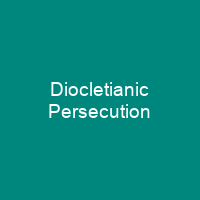In 303, the Emperors Diocletian, Maximian, Galerius, and Constantius issued a series of edicts rescinding Christians’ legal rights and demanding that they comply with traditional religious practices. Later edicts targeted the clergy and demanded universal sacrifice, ordering all inhabitants to sacrifice to the gods. Persecutory laws were nullified by different emperors at different times, but Constantine and Licinius’ Edict of Milan has traditionally marked the end of the persecution.
About Diocletianic Persecution in brief

In the first 15 years of his rule, Diocletsian purged the army of Christians and condemned Manicheans to death, and surrounded himself with public opponents of Christianity. In 313, Constantine restored Christians to full legal equality and returned property that had been confiscated during the persecutors’ reign. In 306, the usurper Maxentius ousted Maximian’s successor Severus, promising full religious toleration. In 311, Maximinus ended the persecution in the East in 311, but it was resumed in Egypt, Palestine, and Asia Minor by his successor,. Maximinus’s successor, Constantine and licinius, signed the Edicts of Milan in 313, which offered a more comprehensive acceptance of Christianity thanGalerius’s edict had provided. In 303, Constantius was unenthusiastic, and later persecutory edicts, including the calls for universal sacrifice were not applied in his domain. In 302, the oracle’s reply was read as an endorsement of Galersius’s position, and a general persecution was called on February 24, 303. The persecution did, however, cause many churches to split between those who had complied with imperial authority, andThose who had remained “pure”. The donatists would notbe reconciled with the Churchuntil after 411, when they were reconciled.
You want to know more about Diocletianic Persecution?
This page is based on the article Diocletianic Persecution published in Wikipedia (as of Nov. 05, 2020) and was automatically summarized using artificial intelligence.







